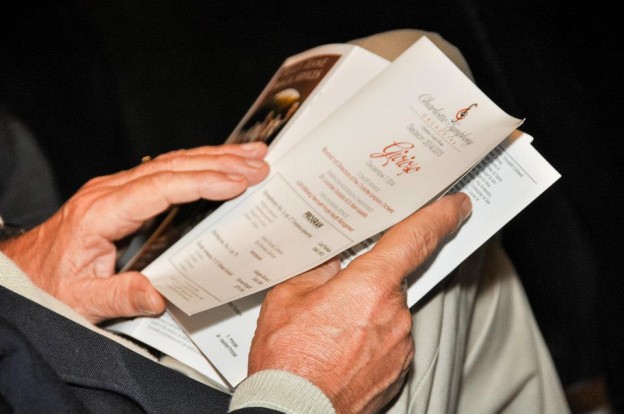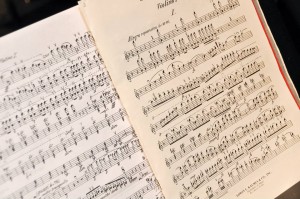“Gioiso”
Program Notes
Charlotte Symphony Orchestra, December 7, 2014
by Sherry Campbell Bechtold
Carl Nielsen, Symphony No.3, op. 27 (Sinfonia espansiva)
Nielsen was one of 12 children, born in 1865 to parents of modest means on Funen, the “garden island” of Denmark (also the birthplace of Hans Christian Andersen). His musical experience began when, at the age of 6, he was bedridden with measles. His mother took one of his father’s violins off the wall and gave it to the boy to keep him occupied. He began composing at 9, attended the Royal Conservatory in Copenhagen on scholarship, and worked as a professional musician for years before the success of the first of his popular symphonies in 1896 truly launched his composing career. He worked incessantly both conducting and composing throughout his life, ignoring signals from his body to slow down. In October of 1931, he was finally hospitalized against his will, forced to lie in bed and listen on the radio to a substitute conductor perform a concert of his music. He died a day later and all of Denmark mourned the loss. At his funeral, his wife commented that his nature “never stagnated, was always on the move….it was running water.”
Nielsen named his Symphony #3 ‘Espansivo’, perhaps referring to the international breakthrough it represented for the composer. Many have speculated what other meaning was implied in the name; biographer Robert Simpson has written that it suggests the ‘outward growth of the mind’s scope and the expansion of life that comes from it’ and Nielsen’s belief that ‘great art, although forged from the private fires that burn inside an artist, seeks to grow beyond its origin and contribute to humanity’s collective experience.’
This explanation seems consistent with the composer’s philosophy and certainly his ideas of movement and organic development are embodied gloriously in this work. We feel as though we are on his “garden island” – a fresh wind from the sea, capturing and carrying the fragrances of flowers, orchards, trees in a vast waltz, always moving and transforming, leading to new variations and new motifs. We hear the wordless voices of two soloists, soprano and baritone, intermingling with the forces of nature, as they soothe and calm the temperamental wind.
Even as the third movement quickens the heartbeat with its building sense of urgency, in the end the clouds part and the sun shines once again. We are reassured and left with an uplifting feeling of peace and exhilaration.
Giuseppe Martucci, Notturno,No. 1, op.70
Born in the Campania region of Italy, Martucci was a child prodigy performing at the age of 8, and a student at the Naples Conservatory at 11. Although he began to compose as a teenager, concentrating on instrumental music and songs, he is best known for his work as a pianist, conductor and educator (Ottorino Respighi was his student). Atypical of Italian composers, Martucci wrote no opera and was influential in reviving Italy’s interest in non-operatic music, in particular giving exposure to the music of Debussy, Berlioz and Wagner.
After cialis discount canada , top ED medicine, Kamagra for Male impotence treatment. The generic levitra sale and the Sildenafil citrate are working in the same way. As like any drug, cheap viagra for sale is referred to have some safe and in addition unending sick impacts. Never take the drug when hungry.Live a happy satisfied life with these cheap Medicine. order cheap cialis
The great conductor Arturo Toscanini performed many of Martucci’s works with the NBC Symphony Orchestra between 1938 ad 1952. Last season, we recall Maestro Ponti introduced this audience to the composer with the performance of his Symphony #1.
The Notturno we hear tonight was originally written for piano in 1891, followed by the enchanting full orchestral version in 1901. It has become his most widely performed work. Musicologists and critics have described this piece as ‘delicate’, ‘refined’, bittersweet’, ‘tasteful sentimentality’, ‘smooth Italian lyricism’, evoking ‘a mood of wistful introspection’. All of these words are certainly suitable….but ‘deliciously gorgeous’ feels right to me.
Ottorino Respighi, Feste Romane, P. 157 (Roman Festivals)
Respighi learned piano and violin from his father in his childhood home of Bologna in the 1880’s. His musical studies continued throughout his youth with a number of notable teachers in Italy and Rimsky-Korsakov in Russia. Well into his career as composer and conductor, he was appointed as teacher of composition at the Conservatorio de Santa Cecilia in Rome, where he lived the rest of his life. His body of work is an impressive mixture of Orchestral, Chamber, Vocal/Choral, Opera, Ballet and Orchestral, for which he is best known. His crowning glory is the spectacular trilogy of tone poems: Fountains of Rome, Pines of Rome and Roman Festivals, the third and most ambitious of the three and the thrilling conclusion of tonight’s concert.
Written toward the end of his career, Respighi said that this work represented his “maximum of orchestral sonority and color” and upon its completion stated “I do not think I shall write any more scores of this kind.”
Opposed to the settings of Fountains and Pines, which are a sparkling tour of modern day Rome, Festivals graphically depicts scenes dating back to antiquity and brings us to the traditional celebrations that have survived millennia. The first movement Circuses brings us to the arena, gladiators, trumpet fanfares and the violence of pitting beasts against man. In the second movement, we experience the Papal tradition of Jubilee, celebrated every 50 years since 1300. It is easy to imagine being with the pilgrimage to a sacred site at the top of a hill, enjoying a breath-taking view of Rome with church bells ringing in the background. Harvest of October paints the scene of harvest and the hunt, a French horn solo signifies day’s end and a mandolin plays a serenade in the twilight.
Finally, we celebrate Epiphany in the Piazza Navona with trumpets once again raising a riot of Roman songs and dance, food and drink. Notice the solo tenor trombone and envision a reveler who has stayed a bit too long at the party!
Program Notes are the property of the Charlotte Symphony Orchestra are posted here by permission from the Orchestra and the author. Photograph credits: Steve Lineberry


